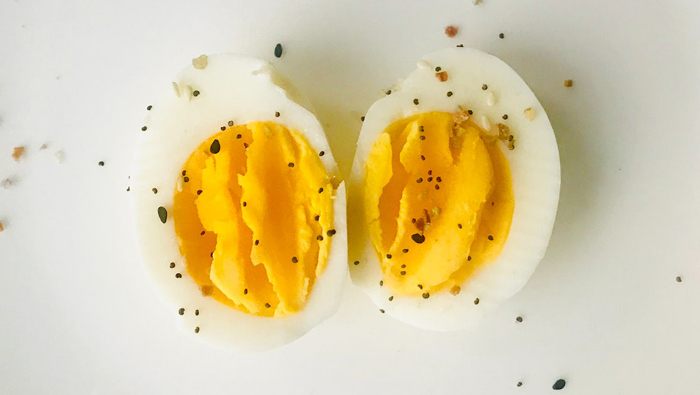
Find out more

Read the article

Find out more

Read the article

Find out more
An egg is the reproductive cell of birds containing all the components necessary for the development of an embryo. The egg consists of a calcareous, porous shell with two parchment membranes underneath containing an air chamber between them, which grows with time. Beneath the membranes there is the egg white and the centrally located yolk, which is attached to membranes by chalazae.
In Poland, eggs for consumption come primarily from hens, the quail or the guineafowl. A freshly laid hen egg contains: 80% of water, 11% of protein, 0.6% of carbohydrates and 0.4% of minerals.
An egg size depends on the age of the hen, its breed and the type of feed. The average weight of a hen egg is 50-65g. Eggs can be divided into the following weight classes: XL (73g), L (63-73g); M (53-63g) and S (< 53g).
The date of minimum durability of eggs is 28 days after laying. Eggs should be stored refrigerated (4-5⁰C). Eggs should not be washed during storage because the outer shell is covered with a cuticle, the so-called mucin casing, which serves as the natural protection of the egg against bacteria. The outer surface of the eggshell may contain pathogenic microorganisms responsible for food poisoning. Always remember to wash the shell in warm water with detergent and rinse with running water before using eggs for cooking. Another form of disinfection is scalding, i.e. immersing an egg in boiling water for 10-15 seconds.
The shelf life of an egg depends on its qualitative characteristics, such as the state of the air chamber, the structural characteristics of the white and the yolk, the absence of foreign bodies and blood spots, the central position of the yolk and the taste and smell corresponding to a fresh egg.
During storage, egg contents undergo certain changes, for example: the air chamber enlarges > 6mm, the shell becomes marbled, the egg weight decreases due to water
evaporation and CO2 escape, the vitelline membrane breaks (yolk separation), the white loses its gelatinous consistency and the yolk becomes turbid.

Freshness can be assessed for an egg in a shell, after breaking and after cooking. At home, it is advisable to carry out a water test by submerging the egg in a pan of cold water and observing its position. The older the egg, the larger the air chamber - and the smaller the egg mass. A fresh egg (a few days old) lies horizontally on the bottom of the pan, an older egg (2-3 weeks old) floats in the middle of the vessel and a stale egg floats just near the surface.
The freshness of an egg can also be assessed when it is placed on a plate. You need to look for the appearance of the yolk and the white. If the yolk is small and convex with visible chalazae, and the white is colourless, clear and thick, this indicates the egg is fresh.
Always pay attention to the appearance of the shell, which for a fresh egg should be clean, translucent and coarse, without any thickening or damage. On the other hand, a slippery, shiny and non-transparent shell is the indication of a stale egg.
Eggs are low-calorie food; 100g of hen egg contents provide 139kcal, including 49kcal/100g provided by proteins and 314kcal/100g provided by the yolk. They are a valuable source of vitamins A, D, B2 and minerals (Ca, Mg, K, P, Chl, Fe, Zn, J). An egg white is a wholesome protein of high biological value, being the source of all essential amino acids and most of non-essential ones. Egg fat is characterized by a high level of digestibility. Yolk lipids include triacylglycerols rich in oleic and linoleic acid, phospholipids and cholesterol.
One of the most popular methods of egg preparation is boiling. Depending on the cooking time, there are soft-boiled eggs (cooking time 3-4 minutes), semi-hard-boiled eggs (cooking time 4-5 minutes) and hard-boiled eggs (cooking time 8-10 minutes). It should be noted that for soft-boiled and semi-hard-boiled eggs the cooking process should begin by placing the eggs in boiling water (high temperature quickly denatures the contents closest to the shell making it difficult for the heat to penetrate deep into the egg), whereas when cooking hard-boiled eggs, you should place them in cold water (this allows slow heating and denaturation of the egg contents).
Opinions on the effects of eggs on human health are divided. The analysis of six American studies (29615 participants) found that increased daily consumption of cholesterol or eggs was associated with the increased risk of cardiovascular incidents and mortality from any cause. Another study from June 2021, including 23 observational studies (nearly 1.4 million participants, mean follow-up period: 12.3 years) of moderate to high quality concluded that there was no association between increased egg consumption and the increased risk of cardiovascular incidents. Current guidelines emphasise more the recommendation to
eat a healthy, varied diet rather than to impose specific cholesterol-related limits (American Heart Association/American College of Cardiology), and the US guidelines (Dietary Guidelines for Americans (2015-2020)) mention the need to limit cholesterol intake as much as possible. According to Polish standards for healthy people, adolescents and children, it is acceptable to eat one egg a day.
Agata Skop-Lewandowska, PhD has been working as a teacher and researcher at the Department of Hygiene and Dietetics of the Jagiellonian University Medical College for 15 years. Her research interests include nutrition of healthy people and patients with a particular emphasis on the nutrition of the older population.
I like
people liked this article